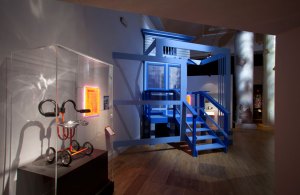I am going to see the Damien Hirst retrospective at the Tate Modern tomorrow, so I may try my hand at a review afterwards. This is one I wrote on the V&A's Postmodernism exhibition last winter. Topical.
The V&A's showcase exhibition on Postmodernism, 'Style and Subversion', closes on 15th January. In attempting to give a surveyable representation of postmodernism, the show is ambitious, if only because Postmodernism is such an all encompassing, uncodifiable movement. Postmodernism first rears its head in architecture, and shows up in design, fashion, music, film - and that's without mentioning literature. Given its inescapable reach, the curators have had to find a way of presenting pretty much every outlet of cultural expression in a single show. In this respect, the exhibition itself is a work of postmodern bricolage.
To begin with, the movement's roots in architecture are laid bare, and we are treated to scenes from the Las Vegas strip, houses and beach huts that po-mo architects designed for their own use, and witty drawings of buildings that can never be.
Naturally, some of the pieces displayed here are just hideous, a case in point being the reconstruction of Charles Jenck's Garagia Rotunda, a pastel blue shack with a plaster-cast Medusa head keeping look-out on one side. However, it would be difficult not to be dazzled by the neon lights of Vegas, cleverly presented in a wall-sized projection of a night time ride down the strip filmed through a car windscreen. Another highlight is Brodsky & Utkin's droll Columbarium Habitabile; a drawing of a columbarium of vast, modernist, proportions, which instead of housing statues and busts, serves as a sort of refuge for beautiful old houses.
Walking through five enormous columns, and past a screening of a short segment of Blade-Runner and a few interesting objects of the post-apocalypse, concrete turntables, and the like, you enter the next major section of the exhibition concerned with furniture and design.
The objects here are tongue in cheek takes on everyday household objects. Lamps on wheels, stools that do not look particularly comfortable to sit on, and strange, spouted creations that appear to be ironic teapots (indeed, the number of teapots showcased at the exhibition reaches the level of an amusing curatorial joke). The items here are not beautiful, but nor did they strike me as crass or tasteless. At the very least, many of them will provoke a smile, and they serve to convey an important facet of postmodernism's anti-modernist agenda: form over function.
Next comes the the performance section - after being greeted by a scarily lifelike hologram of Boy George, and traversing a walkway abreast another clip from BladeRunner, you reach the room of the exhibition that perhaps most truly captures the essence of postmodernism, and my favourite bit of the show. On each side of the room there are huge screens simultaneously showing Klaus Nomi, the Talking Heads and Grace Jones, with the audio alternating between them. At ground level there are collections of screens and monitors playing everything from music videos like Nenah Cherry's 'Buffalo Stance' and Devo's 'Whip it', to strange dancing by masked wrestlers and a pantomime horse. And high up on the walls, there are fabulous costumes from the 70s and 80s music scene, including the Grace Jones maternity dress that has been used in much of the exhibition's publicity. The room is turned into a bewildering visual barrage that might be said to be postmodernism made manifest in a single space.
There is at least one respect, however, in which the exhibition is not very postmodern at all - it tells a story, there is a narrative. This is tied up neatly by the final section, which contains some Warhol, some glitzier examples of postmodern architecture such as the AT&T building, a Han dynasty vase branded with the Coca-Cola logo (WeiWei) and, of course, many more teapots. This is a depiction of postmodernism becoming the dominant style of the corporate/commodity culture of the 1980s - a depiction of a collusion of art and capital. The tale of the exhibition, then, has postmodernism beginning as a rebellion against the rules, strictures and bland uniformity of modernism, injecting freedom, vibrancy and vitality into art and the world around us; however, postmodernism's success turns into excess, revelling in the world of commodity, a la Warhol, rather than being engaged in social criticism.
In this respect, the exhibition is a critique of postmodernism. Indeed, at the beginning of the final section the panel text quotes Frederic Jameson on Warhol's paintings - "they
ought to be powerful and critical political statements. If they are not that, one would certainly want to know why." I am unconvinced by the Marxist notion that the art has to be criticising the capitalist system in order to be of any value. If later postmodern art did not make political statements, then it did make statements like, "I'm having a great time! Now look at this cool teapot!" And I do not see why that is such a bad thing.
Nevertheless, the exhibition is also a celebration of postmodernism. The curators have brought together a collection of the weird and the wonderful from all over the world - from Ghana to Japan. The finale to the exhibition is New Order's 'Bizarre Love Triangle' music video, which poses the question "Why can’t we be ourselves like we were yesterday?", which I pondered with a smug, knowing smile on my face as I followed the neon 'SHOP' sign into the giftshop. A sign which not only lights up the high quality collection of kitsch in the V&A giftshop, but also the fact that if postmodernism ever went away, it is just as strong as ever today.
By the end of the exhibition I felt that postmodernism had made the world a much more lively and vivacious place, even if it did usher in an age of self-aware conceitedness that even the best of us can be caught in the act of. Moreover, the exhibition design and curation is stunning and stylish, and the curators succeed in tying together all of the artforms on offer, which was perhaps the greatest challenge posed by the concept of the show. If you can get to the V&A during the first two weeks of 2012, then you should, because you won't see anything like this exhibition for a long time to come.




No comments:
Post a Comment